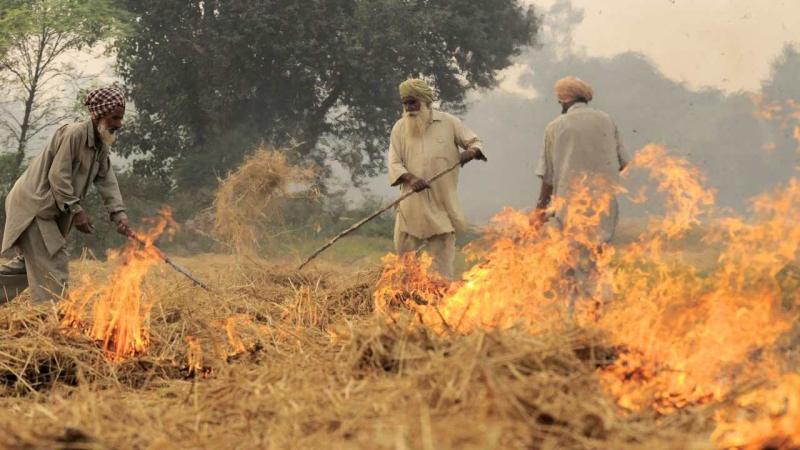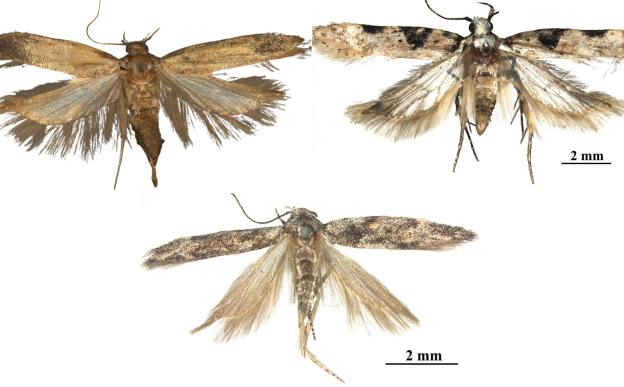
Burning of rice residues after harvest, to quickly prepare the land for wheat planting, around Sangrur, Punjab, India. [Image Credit: Neil Palmer (CIAT) via Wikimedia Commons CC BY-SA 2.0]
In India, about 2.5 million farmers in the Indo-Gangetic plains grow two crops a year—rice and wheat. Rice is planted such that its water requirements are met from the monsoon rain, and within a short period of 10 to 20 days, the fields are cleared for wheat. A convenient way to get rid of the whopping 23 million metric ton of grass and hay left behind by rice cultivation is to burn them. However, this practice contributes to air pollution in cities like Delhi, where the air quality is already the worst in the world.
In 2017, researchers from The Nature Conservancy (TNC), an environmental organisation headquartered in the US, met with a few collaborators from different institutes in India, to discuss this ‘burning’ problem and find alternatives to the practice. Although crop burning is prohibited, farmers continue to defy the ban, due to a lack of greener alternatives that are feasible, affordable and scalable.
“This is why we decided to take a look at the practice from an economic and a scientific standpoint,” says Dr Priya Shyamsundar, an economist working with TNC, in an interview with Research Matters.
In a new study, Dr Shyamsundar and her collaborators from India, Mexico and the USA, have evaluated the impact of alternative practices to stubble burning on the environment, and their profitability. The analysis, published in the journal Science, finds that using Happy Seeder—a machine that can sow wheat in the presence of rice straw—is profitable for farmers and can also help the environment.

Happy Seeder. Photo Credit: Natalya Skiba at TNC.
The researchers collected data about farm practices, the costs involved and the yields of crops, from previous studies, field trials and surveys. They then calculated the net profit generated by burning and no-burning practices like baling, straw incorporation into the fields, and mulching, where the straw is spread on the field. Their analysis was based on the market prices, yields, labour and other costs incurred for land preparation and crop production.
The researchers found that using the Happy Seeder led to a nearly 10-20% increase in farmer profits on average. Thus, farmers can, on average, reap a benefit of INR 11498 per hectare by switching from the most common burning practices to the use of a Happy Seeder for mulching. The machine can be mounted on a tractor, and it cuts and lifts rice straw, sows wheat into the bare soil, and deposits the straw over the planted area as mulch.
“With Happy Seeder, the land preparation cost is often less than other practices that use a combination of machinery,” says Dr Shyamsundar. “Since it reuses the crop residue in the field, the biomass improves soil moisture and could be good for the long-term health of the soil,” she adds.
The researchers also found that the use of Happy Seeder reduced agricultural greenhouse emissions per hectare by 78% or more relative to burn options. For each hectare, all the farming options considered that do not include burning, showed a lower contribution to particulate air pollution. Such practices can reduce agriculture’s contributions to India’s greenhouse gas emissions and contribute to better health by reducing air pollution, say the researchers.
However, not all farmers currently have access to equipment like the Happy Seeder. “The Happy Seeder is not affordable for everyone, and there needs to be more available options for renting these machines,” opines Dr Shyamsundar. Even though the manufacturing of these machines has increased in the last two years, an investment of INR 2.4 billion is necessary to produce about 16,000 machines to cater to 50% of the rice-wheat cultivated areas.
The researchers suggest that the government and the private sector can play an active role in increasing the adoption of no-burn practices. Currently, the government provides a significant subsidy to farmers to buy machines to manage crop residue. But, there is more to be done, opines Dr Shyamsundar. “There needs to be a predictable set of rules regarding stubble burning and its thorough implementation,” she argues. The private sector can invest in manufacturing farm equipment that helps no-burn farming locally and increasing rental availability of Happy Seeders, which can help with managing demand and supply.
Drafting a communication strategy that involves access to information on no-burn alternatives is the need of the hour. “Involving educational institutions, farm extension services, awareness drives on profitability and viability, and organising practical demonstrations go a long way in this regard,” says Dr Shyamsundar. Since farmers learn from each other, nudging them by showcasing success stories from their peers can be very useful, she suggests.
The findings of the study show that there is an immense opportunity for India to cut down on air pollution and greenhouse gas emissions from stubble burning without affecting farmer revenues. The researchers have shared their findings with the Indian Council for Agricultural Research (ICAR). The Nature Conservancy, India, has partnered with organisations like the International Maize and Wheat Improvement Center (CIMMYT) and the Council on Energy, Environment and Water (CEEW) to take these findings to the farmers through awareness, training and demonstration programs in Punjab, Haryana and Uttar Pradesh.
“India has so many environmental problems, and there is always the story that if you resolve one, there are other trade-offs. On the contrary, our analyses show an economic opportunity that also reduces environmental problems,” signs off Dr Shyamsundar.
This article has been run past the researchers, whose work is covered, to ensure accuracy.
Editor's Note: The Happy Seeder photo was updated based on researcher's inputs.






